Content creation can be a scary thing. Whether you’re new to content marketing, struggling to get your operation off the ground, or constantly hitting roadblocks, the struggle is real. We get it. We’ve been creating content for a decade, and over the years we’ve hit just about every hurdle and made every mistake on the planet.
Naturally, we’ve learned a lot along the way. But perhaps the most significant thing we’ve learned is that anyone can master content creation. Having worked with brands of all sizes, we can definitively say that size doesn’t necessarily matter. We’ve seen large teams with big budgets struggle to get projects out the door, and we’ve seen two-person teams create a consistent stream of quality content that helps them achieve their marketing goals.
What really matters is understanding how to create content in a way that works for you, and building a solid production process with the flexibility to roll with the punches. If you’ve been struggling to create content well or overwhelmed at the idea of doing it at all, you don’t need to be. Here, we’ll break down everything you need to know about content creation, along with our best tips, tools, and resources.
What Is Content Creation?
It’s exactly what you think it is: the act of creating content. However, while it may seem obvious, when it comes to marketing there’s a big difference between creating content and creating content that actually supports your marketing goals. Mastering content creation means you are creating high-value content that serves the people you’re trying to reach.
At a time when engagement marketing is taking over disruption marketing, it’s more imperative for brands to create content than ever before. (According to Aberdeen research, brands pursuing content marketing have a 6x higher conversion rate than brands not doing content marketing.)
Unfortunately, creating truly great content takes skill, and many brands find themselves struggling to do it well.
Common Barriers to Successful Content Creation
Content creation can be a challenge for many reasons. In organizations of all sizes, we find it usually comes down to the same general issues:
- Time
- Money
- Resources
- Knowledge
- Infrastructure
Sometimes there are internal politics or team dynamics that can get in the way, too (especially if you don’t have buy-in from higher ups). While these things can be frustrating, with the right vision and plan, you can still create worthwhile content that will move people along the buyer’s journey.
What to Do Before You Dive Into Content Creation
Having worked on content of all sorts, from infographics and motion graphics to videos and e-books, we know that good content doesn’t start with a first draft. It starts with understanding exactly what you’re trying to achieve. So, before you start writing a blog or briefing a designer, take the time to do your due diligence.
- Start with a discovery phase. If you’re new to content creation or looking to revise your approach, start with a general audit. What are you doing that’s working? What’s causing problems? What would you like to explore? What could you be doing better? What is your competition doing well? This research should help you gather key insights to inform your content approach.
- Craft your content strategy. Shockingly, 26% of B2C marketers and 23% of B2B marketers don’t have a documented content strategy, according to the Content Marketing Institute. In our experience, we can say this is definitely of the most common mistakes brands make. Creating content without a plan is shortsighted, inefficient, and costly. Follow our guide to document your content strategy if you haven’t done one before. A strong strategy ensures your content will actually move the needle.
- Know your goal. If you’ve done your content strategy correctly, you should know your goal. We’re simply reiterating its importance because it is your North Star. Every aspect of your content is informed by your goal, so make sure everyone on the team knows not just what they’re doing but why they’re doing it.
- Assign the right roles on your team. You don’t need a ton of new hires to build a great content marketing team; it’s really about making sure every responsibility is covered. Find out what roles you need to assign, and bring in reinforcements if you need.
- Assess your resources, bandwidth, and capabilities. Depending on the type of content you’re creating, you may or may not have the skills or bandwidth necessary to produce it. For example, interactive or animated content requires more expertise than an infographic. Trust us, underestimating the skill or amount of work required to create content is another common oversight. With a high-level understanding of the type of content you’re creating, you can determine how you may need to supplement your team. (BTW, here’s how to decide if you should DIY, use a freelancer, or bring in a creative agency.)
- Map your buyer’s journey. To make effective content, you need to say the right thing at the right time. Here’s how to map your buyer’s journey to make sure your messaging is on point, no matter what form it takes.
Once you have these elements locked, you can start to build out your production process and craft your content.
But one note before you proceed: We’ve seen plenty of brands dive into content creation enthusiastically but get frustrated or give up when they hit a snag or unexpected roadblock. In many ways, these little hiccups are to be expected. But you can also navigate content a little easier if you keep the following tips in mind.
- Start small. There’s no rule that says you have to go from zero to 100. When it comes to content, we’re all about experimentation, starting small, and running lean (if need be)—at least to start.
- Give specific feedback. Everyone has opinions, but you need one point person to collect, collate, and consolidate actionable feedback. This will help things go smoother and help your team stick to deadlines.
- Don’t get paralyzed by perfection. It’s tempting to want to make everything “just right,” but too often that results in a line of half-done projects that never see the light of day. (Worse, one stalled project can push other potentially awesome projects back indefinitely.)
- Don’t get discouraged. Content creation is like anything: the more you do it, the better you get at it. It’s also important to remember not to get too down on yourself if you don’t immediately see the results you want or if you hit a roadblock. It’s how you learn.
- Stay open and flexible. Yes, you want to build an infrastructure and process that works, but you don’t want to be too rigid. If there’s a way to do things more efficiently or effectively, be open to it (aka talk to your team about how things are going).
- Measure, measure, measure. In addition to your internal content creation process, make sure to measure how your content is doing in the real world. If you find, for example, that your e-books aren’t doing as well as your infographics, you can correct course and focus your efforts on what works. (Here are some metrics you might want to start with.)
That said, there are plenty of ways to make content creation a lot easier. And that’s what you’re here for, isn’t it?
How to Create Content At Every Stage of the Process
How do you bring your ideas to fruition, navigate potential roadblocks, and finish with a piece of content you’re truly proud of? We’ve compiled our best tips to walk you through every stage of the process, from brainstorming to publishing.
STEP 1: Brainstorming
With your content strategy complete and your goal in mind, you get to start with the fun but sometimes frustrating part: brainstorming. Unfortunately, many brands forget that brainstorming isn’t about finding the fun idea; it’s about finding the right idea. (Also, remember that your first idea is rarely your best—it’s often the first thing your competitors have thought of, too.) Therefore, it’s important to help your team tap into their creativity and funnel that energy in the right direction.
- Write a strong creative brief. A creative brief is a tool to keep everyone on the same page. It outlines all of the need-to-know details about a project, including things like goals, deadline, budget, etc. Start with our guide to write a creative brief that people can actually use.
- Think about who you’re trying to reach. Sure, it’s tempting to go with a cool idea that you like, but it’s not about you. It’s about the people who are going to consume your content. Marketing personas are a great tool to help you identify what it is your target groups need and want. If you can create content that provides value to them, you’re golden. Follow our guide to create personas if you haven’t made them already.
- Follow brainstorm best practices. There are a lot of little things you can do to make your brainstorms more fruitful. (FYI, banning devices is our top tip.) Check out our 10 tips for better brainstorms to set your team up for success.
- Try a prompt. Sometimes you need a little something to kickstart your inspiration. Here are 9 content idea prompts that can get your creative juices flowing.
- Think about what’s trending. Are there newsworthy topics that you could talk about authoritatively? This can be a great way to come up with ideas, but it can be tricky. To avoid any issues, find out how to newsjack without being a jackass.
- Consider user-generated content. This can be a relatively easy way to craft content that resonates with people. Here are 11 ideas to get you started.
- Mix it up if you get stuck. We’ve all been in a brainstorm that goes nowhere. If you’re truly struggling, here are some of our favorite exercises to get unstuck.
- Vet your ideas. You should be able to articulate exactly how your idea serves the people you’re trying to reach and supports your marketing goals. (Again, this is why having a documented content strategy is so important.)
Before you approve any ideas, ask yourself these five questions to find out if it will work.

STEP 2: Prepping
Once you’ve vetted and selected your idea, there’s still some legwork to do before you start drafting content.
- Do some research. There’s nothing more frustrating than coming up with a great idea…that you can’t execute. There are plenty of things that can derail your idea in big and small ways. For example, you might not be able to find the data to support it, or you might realize your competitor already did it. In some cases you might need to scrap the idea; in others you might need to refine the angle or tweak it a little. Either way, it’s always better to kill an idea before you start than scrap the project after you’ve spent a ton of time on it.
- Identify your channels. The type of content you create should work for your chosen distribution channels. For example, if your followers spend a ton of time on Instagram, you’d want to focus on visual content.
If you’re not sure which distribution channels are best for you, here’s a handy guide.
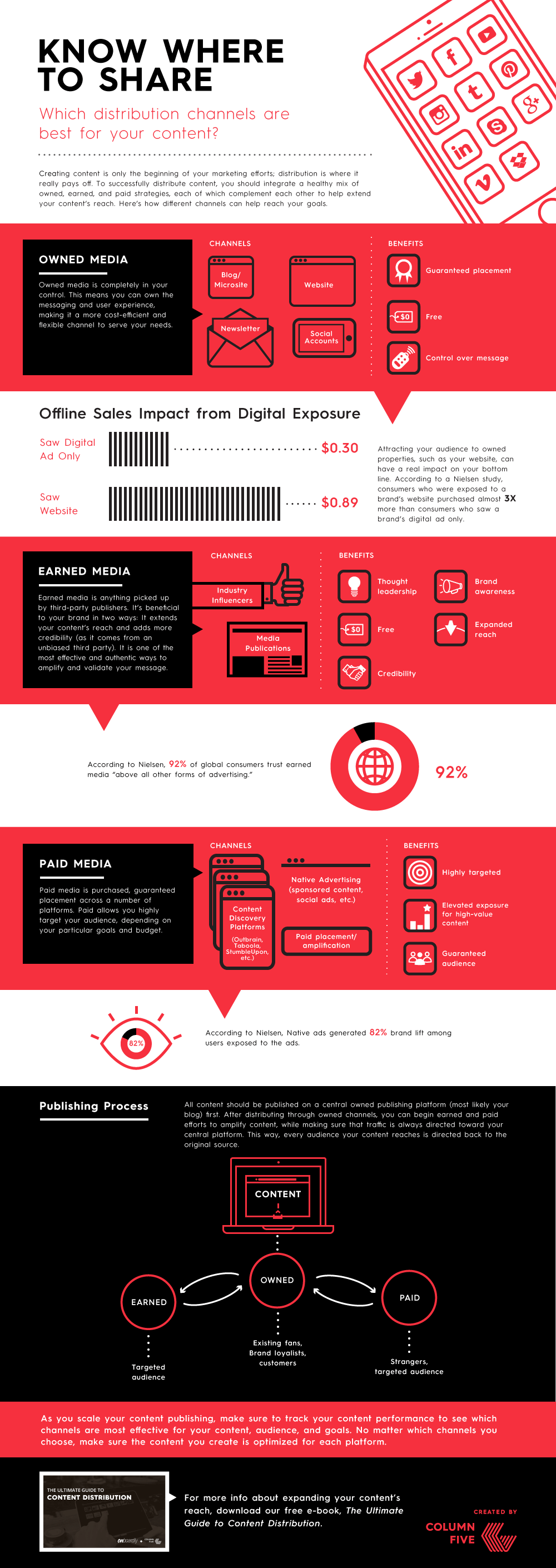
- Choose your format. It’s important to consider what type of format will work best before you dive in. Not only do you want to make sure it’s the right vehicle for your story, you want to make sure it will work with your distribution channels. (For example, we once created an awesome GIF series for a publisher, only to find out that their platform didn’t support GIFs. It hurt.) Here’s how to determine which visual format might fit your story.
- Build a detailed timeline. Your timeline is crucial. We can’t tell you how many times a project missed its deadline because the timeline didn’t account for some major thing. To avoid this massive headache, consider each phase of production: Who needs to be involved? Who needs to provide feedback? Who needs to shepherd the project? Pro tip: Build approval time into each production stage—and don’t move anything into the next phase unless all stakeholders have signed off on it.
- Gather inspiration. To do creative work, you need to be inspired. And if you’re providing creative direction, you often need a reference point. Creating moodboards or compiling links is a great way to help the creative team “envision” what you’re going for. (Personally, we’ve found inspiration in everything from a music video to a bottle label.) If you need some visual examples for inspiration, check out some of our favorite examples of brand storytelling, infographics, rebrands, e-books, annual reports, motion graphics, and explainer videos.
STEP 3: Copywriting
Whether you’re producing visual content (infographics, video, interactives, etc.) or written content (e-books, white papers, blog posts, etc.), most content starts with copy. This is where you’ll nail the beats of your story and outline everything to include. We always start with a draft of written content, then iterate until it’s ready to move into design.
Note: Copy should always be locked before moving on to the next stage, as major edits can cause significant headaches down the road.
- Focus on the story. You want to hook your reader from the jump with a compelling narrative. Whether it’s a script or an infographic, start by beating out the story in five sentences. This will give you a basic narrative structure and help you flesh out the story around it. You can also check out these tips to tell your brand story.
- Find proper sources. Great sources are crucial to make great content, especially when it comes to data storytelling. Use only reputable sources (start with these 100+ free data sources), and attribute sources correctly.
- Use the right language. You want your content to connect with people, so make sure you’re speaking to them, not at them or above them. Avoid too many buzzwords or insider jargon, and always write at a level that your reader can understand.
- Write authentically. People want to build relationships with brands that are honest and transparent. If people feel like you’re overselling or faking, they’ll tune out. To avoid that, follow these tips to get the BS out of your content marketing and learn about the difference between sales and marketing materials.
- Add your brand voice. To build a relationship through content, people need to know who your brand is and what you’re about. Writing copy in your brand voice is the perfect opportunity to show off your personality. We find it helpful to write a first draft, then take a pass for voice. (If you don’t have a sense of your voice, try our easy exercises to uncover your brand voice.)
- Remember your keywords. It’s highly likely that you’re creating digital content, in which case keywords matter. Use them in your headers, body copy, URLs, etc. (Here’s a step-by-step guide to craft a keyword strategy if you’re not sure what words to target.)
- Break through writer’s block. If you’re stuck on a blank page, try our favorite exercises to help you write better copy.
- Edit, edit, edit. In addition to grammar issues, take a pass to check for missing info, inconsistencies (especially if you’re working with data), word choice, tone, brand voice, etc.
For more content-specific writing tips, check out our guides for:
- Crafting an infographic narrative
- Scripting motion graphics, brand videos, and explainer videos (and identifying how long they should be)
- Writing e-books
STEP 4: Designing
The design stage is when things really start coming to life. However, it’s also where production can get held up due to simple oversights or sloppy mistakes. Make sure your team is well-equipped to execute design correctly and effectively with these tips.
- Start with a black-and-white draft. This may be a storyboard or a wireframe. Either way, you want to start with a rough visual that depicts hierarchy, light illustration, typography, etc. We start in black and white so that you can “see” whether or not the core design is there—without the distraction of color, which can easily sway opinions.
- Watch your colors. In general, you want to use 1 or 2 dominant colors, plus 2-3 accent colors. (You should also consider any cultural or emotional associations with color, as these factors may influence how people consume your content.)
- Limit your fonts. Use 2-3, including a primary brand typeface and secondary typefaces. Also, be mindful of legibility, especially on screens.
- Design modularly. Designing visual content modularly makes it easy to extract visual elements to promote on social or enhance existing content like articles, e-books, white papers, etc.
- Test, test, test. This is crucial for things like interactives, video, and motion graphics. You need to make sure everything is processed correctly, that functionality is working, and that there aren’t any weird things happening.
- Have a copy editor take a final pass at content. You may think everything has made it into design, but it’s easy for a paragraph to get cut out in layout or a typo to find its way into a motion graphic. These mistakes aren’t just inconvenient; they can affect your brand’s credibility.
- Consider adding motion. Animation can greatly enhance static content, capturing attention and providing a more stimulating experience. Whether it’s a GIF, animated infographic, interactive annual report, or motion graphic, motion is a great way to enhance existing content.
For example, this animated infographic is both eye-catching and designed modularly, allowing each “tip” to be extracted and used for promotion on social media.
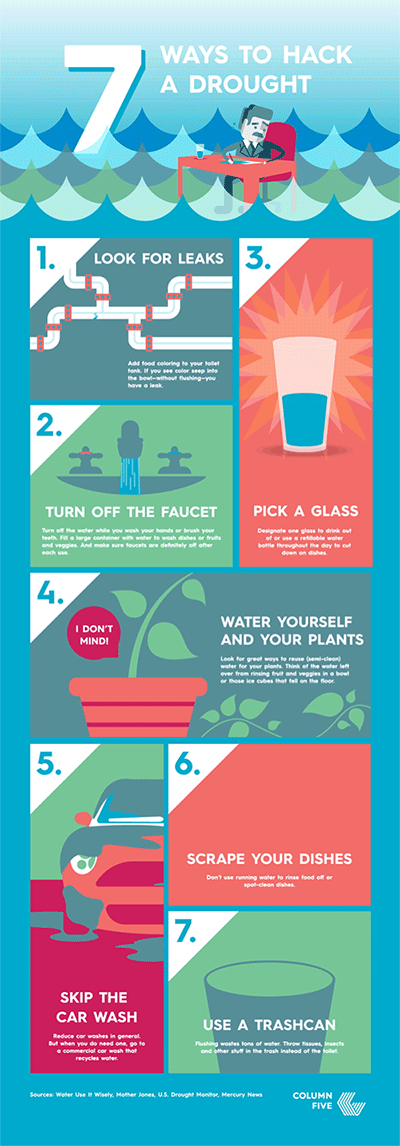
- Use your visual identity. One of the most crucial parts of making branded content is actually branding it. That doesn’t mean you slap a million logos on an infographic; it means you cultivate a consistent aesthetic that communicates your brand. If you haven’t designed a visual identity before, here are 75 tools to help you do it, as well as our step-by-step guides to designing logos and building an identity.
You can also use this checklist to ensure you have a comprehensive visual identity.
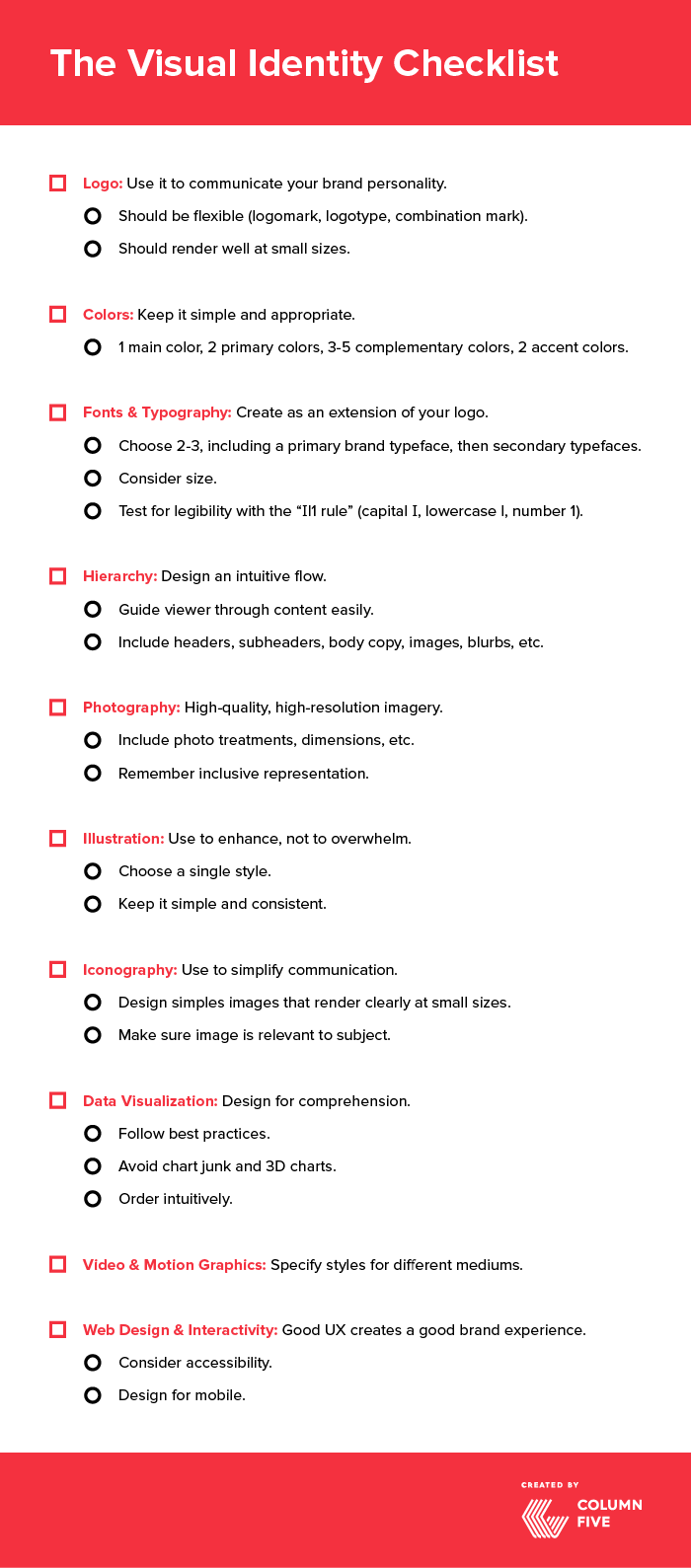
- Follow best practices. Design is powerful because it targets your brain’s visual processing center, allowing for near instant comprehension. Whether you’re telling an emotional story or communicating complex data, design can do the heavy lifting. That said, expert designers know how to optimize design to communicate more effectively, using things like color, size, shape, and layout to make content connect with the viewer. Hence, it’s crucial to follow best practices. You’d be surprised how much these little things can enhance your viewer’s experience.
Start with these 10 useful design tips to improve every piece of visual content.

For more design tips by visual content type, here’s a rundown for:
- Annual reports: Follow these 10 tips to design an attention-grabbing annual report.
- Infographics: Find out everything we’ve learned from making 4,000 infographics, avoid these 15 infographic design mistakes, and make use of these 101 resources and tools to make better infographics.
- Interactive infographics: Find out what it takes to make compelling interactive content.
- Data visualization: Learn how to design the most common charts and graphs, and follow these 25 tips to make your visualizations easier to understand. (Or, if you need help, here’s what to look for in a data visualization agency.)
- E-books: Use these 100+ e-book tools to make designing easier, avoid the 30 most common e-book design mistakes, and consider designing e-book templates for more efficiency in the future.
- Motion graphics: Find out how to make motion graphics in 4 steps, and use these 20+ tips to make motion graphics that make an impact.
- Reports: Find out how to create a report design that reflects your visual identity and how to enhance it with data visualization.
- Presentations: Follow these dos and don’ts of presentation design, and learn how to enhance presentations with data visualization. (If you’re stuck, find out how to vet a presentation design agency.)
- Video: Explore our ultimate brand guide to video, which features tips on every aspect of production, as well as finding an agency if you need.
STEP 5: Publishing
Once your content is complete, you might think your job is done. But what happens after you create content has a huge affect on its success. Hence, it’s important to do as much as you can to ensure your content gets maximum reach.
- Craft a distribution plan. To help your content make a real impact, find out how to craft a strategy in 6 steps, and follow these tips to promote content like an agency would.
- Optimize for SEO. In addition to keywords in copy, make sure your website, blog, and visual content are all optimized for SEO. Find out how to optimize your blog and optimize infographics.
You can also use this handy checklist to make sure all your content is good to go before you publish.
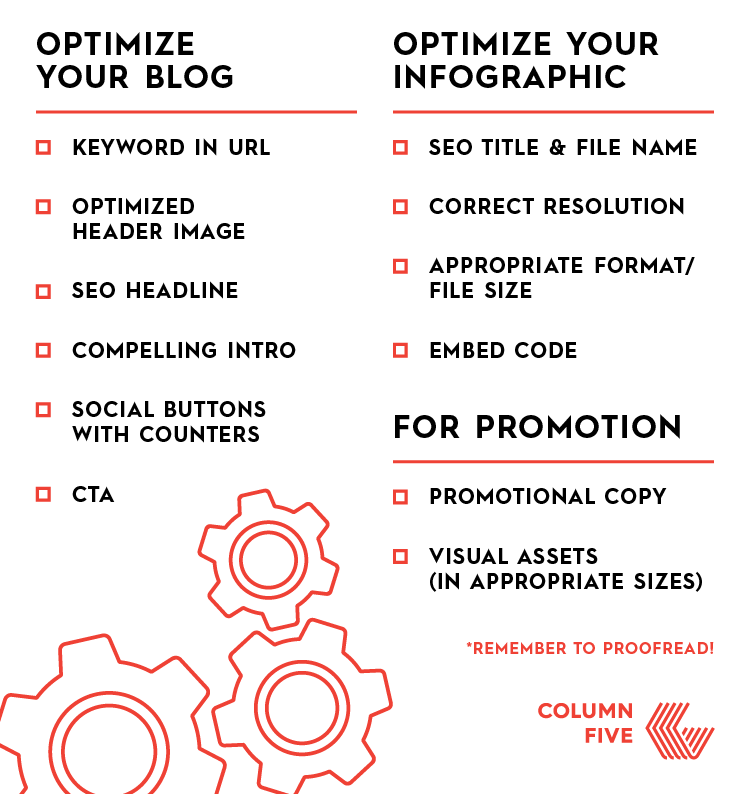
- Maximize your content. One piece of content can be turned into multiple assets, all of which can be used to promote content on different channels. (We call this a divisible content strategy, which includes creating microcontent for social.)
Here’s a quick breakdown of how a divisible content strategy can help you create multiple assets from one.
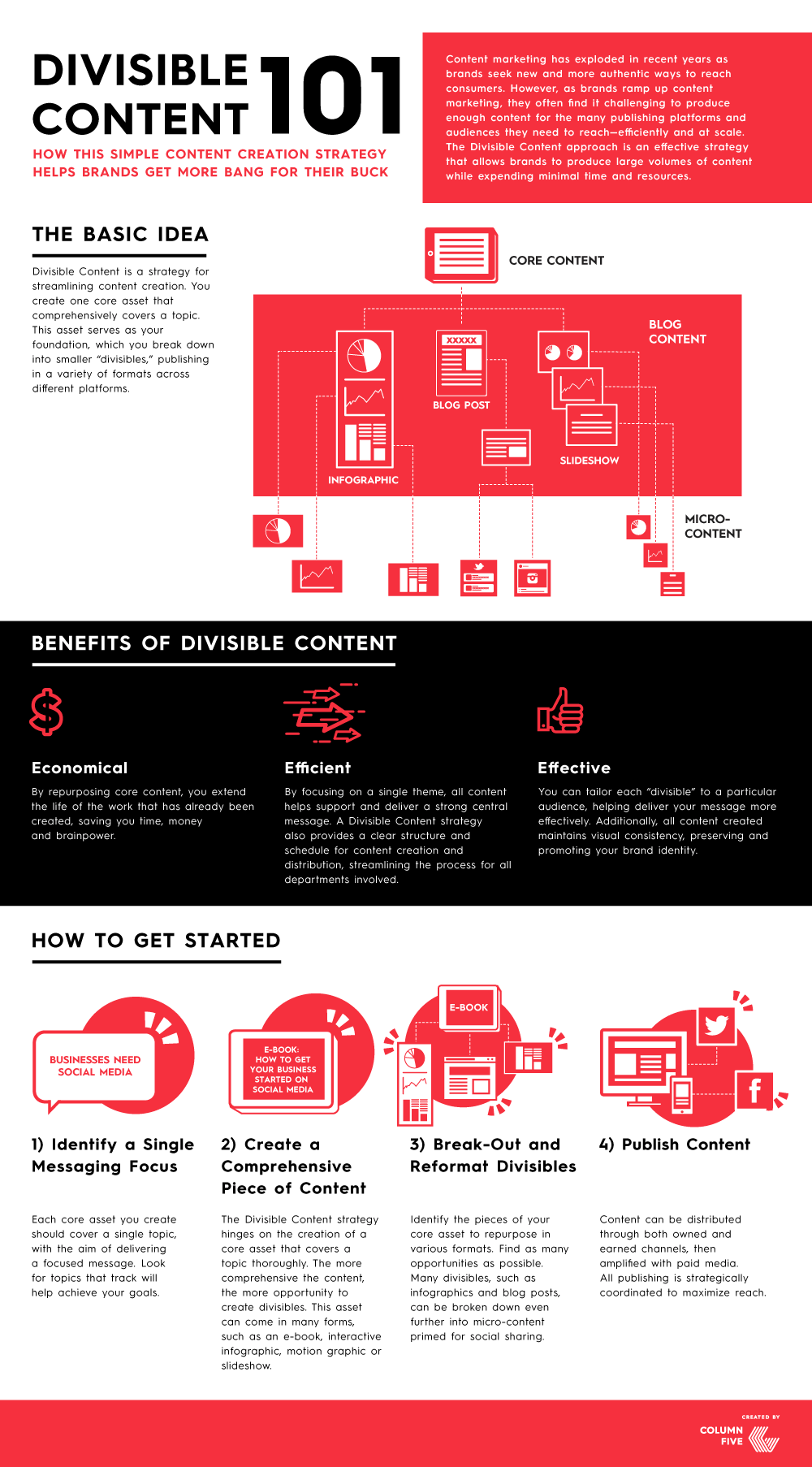
- Reuse and repurpose content. You can also extend the shelf-life of content by repurposing or refreshing it at a later date. For example, you might reuse data visualization to enhance other content or turn old content into a new e-book. This is an efficient way to make the most of what you have.
The Real Key to Effective Content Creation
Ultimately, the true secret to successful content creation is simply experience. The more you do it, the more benefits you’ll see, and the better you’ll become. That said, educating yourself on how to work better, smarter, and more efficiently will only help you get to expert level faster. (By checking out this blog, you’re already doing that.)
If you want to learn more about creating great content, explore more of our resources. And if you’re feeling overwhelmed or need someone to fill in the gaps, holler at us. At the end of the day, we love creating content more than La Croix.





Your perspective on topic is refreshing. I appreciate the way you approached the subject and the useful insights you provided.
Thanks very much—hope it helps!